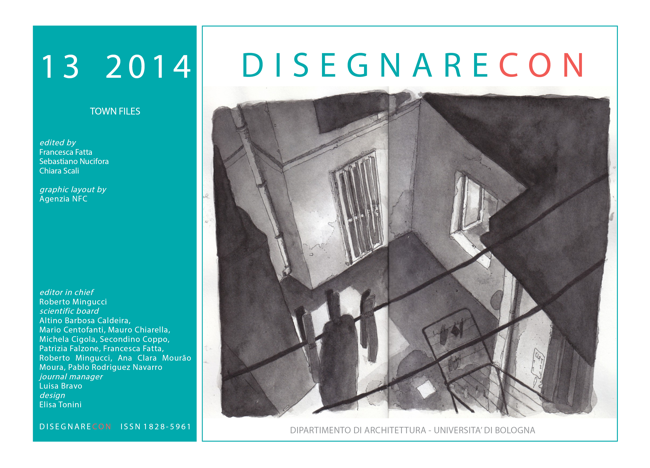True, false, fake. Digital representations of urban landscapes subject to transformation between communication and seduction
DOI:
https://doi.org/10.6092/issn.1828-5961/4096Keywords:
Digital representation, multimediality, urban landscapesAbstract
The representation of transformation of urban landscapes, thanks to the tools offered by the digital convergence, more and more uses of multimedia outputs where the mix between real and virtual is done seamlessly. In the simulations created, true, false, and fake overlap and merge, exerting an undeniable seductive power. Through the analysis of case studies referred to recent intervention of urban regeneration in Europe and experiences personally conducted I will discuss about the limits, the drifts and the potential of these systems of representation and communication.References
Ciotti, Fabio, Roncaglia, Gino (2000), Il mondo digitale. Introduzione ai nuovi media, Laterza, Roma-Bari.
Couch, Chris, Sykes, Olivier, Börstingaus W. (2011), Thirty years of urban regeneration in Britain, Germany and France: The importance of context and of path dependency, in Progress in Planning, 75, pp. 1-52.
de Leonardis, Ota (2013), Il governo con il rendering, in Crios. Critica degli ordinamenti spaziali, 5, pp. 19-32.
Engeli, Maia (1999), Storie digitali. Poetiche della comunicazione, Testo&Immagine, Torino.
Gabellini, Patrizia (2010), Fare urbanistica. Esperienze, comunicazione, memoria, Carocci, Roma.
Garzino, Giorgio, Spallone, Roberta, Lo Turco, Massimiliano (2011), Strategie digitali per modelli conoscitivi, in Garzino, Giorgio (a cura di), Disegno (e) in_formazione. Disegno politecnico, Maggioli Editore, Sant'Arcangelo di Romagna, pp. 70-111.
Ginzburg, Carlo (2006), Il filo e le tracce. Vero, falso, finto. Feltrinelli, Milano.
Maldonado, Tomás (2005), Reale e virtuale, (I ed. 1992), Feltrinelli, Milano.
Manovich, Lev (2011), The Language of New Media, MIT Press, Cambridge.
Marchi, Marzia (2012), Declino e rigenerazione urbana in Europa: i casi di Glasgow e Lipsia, in Memorie Geografiche, n.s. 9, pp. 315-326.
Moriconi, Claudio (2001), Il modello virtuale, in Soletti, Adriana, Belardi, Paolo, Cataliotti, Francesca, Claudio Moriconi professione nfografico, Università degli Studi di Perugia, pp. 20-30.
Ogleby, Cliff (2007), The "Truthlikeness" of Virtual Reality Reconstructions of Architectural Heritage: Concepts and Metadata, in Proceedings of 2nd Internatio-
nal Workshop 3D-ARCH'2007
D Virtual Reconstruction and Visualization of Complex Architectures, International Archives of Photogrammetry, Remote Sensing and Spatial Information Sciences, Vol. XXXVI-5/W47, editors: F. Remondino, S. El-Hakim, ETH Zurich, Switzerland.
Spallone, Roberta, Lo Turco, Massimiliano, Sanna, Marco (2009), Representing ideas by animated digital models in architectural competitions, in ARCC 2009 - Spring Research Conference - Leadership in Architectural Research, between academia and the profession, San Antonio, TX, 15-18 April 2009, pp. 247- 255.
Spallone, Roberta, Lo Turco, Massimiliano, Sanna, Marco (2009), Dimension "Time" to represent contemporary architectural design, in Innovative Design and Construction Technologies. Building complex shapes and beyond - Id&cT09, Maggioli Editore, Santarcangelo di Romagna, pp. 243-258.
Spallone, Roberta, Lo Turco, Massimiliano, Sanna, Marco (2012), From the place of research to the research of place: new digital technologies for simulating future architectures in building environments, in ARCC-EAAE 2010 International Conference on Architectural Research, The place of research/ The research of place, Washington DC, USA, 23th-26 th June 2010, pp. 101-108.
Szalapaj, P. (2005), Contemporary Architecture and the Digital Design Process, Architectural Press, Massachusetts.
Terzidis, Kostas (2008), First international Conference on Critical Digital: What Matter(s)?, Harvard University Graduate School of Design.
Downloads
Published
How to Cite
Issue
Section
License
Copyright (c) 2014 Roberta Spallone





